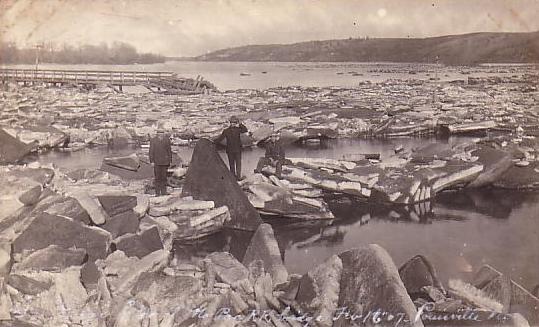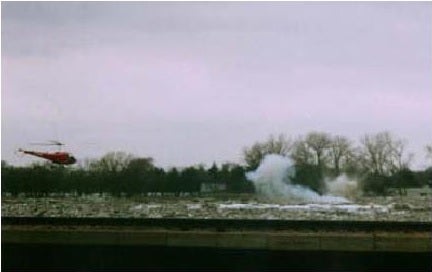By Mitch Paine, CFM
From December 2014 Floodplain Management Today
As ice builds up in the shallow Platte River every winter, there is a false sense of security about a river that appears stopped in motion. But, as the temperatures rise later in the season, so does residents’ and communities’ anxiety about the potential for ice jam flooding. The large ice chunks that break up with warming temperatures and late winter rainfall flow downstream, and too much ice can cause flooding.

When ice builds up against a bridge or a bend in the river, it backs the river up, potentially for miles. The water flowing from upstream spills out onto the floodplain and can destroy roads, bridges, crops, or wellhouses as well as homes and businesses. When the ice finally gives way, water held back flushes down and can then cause significant flooding downstream.
A wide swath of the northern United States suffers similar frozen river fates every winter.
Flooding from ice jams affects states like Montana, Wyoming, New York, and New Hampshire. Many rivers in Nebraska see this problem as well. The Loup River and its tributaries are among the most notorious for the number of ice jams every year in the country, although flooding causes much less damage than other places.
Because flooding can happen very quickly and can imperil riverside residents, ice jams cause major worry for emergency managers along the Lower Platte River. The best way to reduce the risk is continuous monitoring. The Papio-Missouri River Natural Resources District partners with the Lower Platte South and Lower Platte North NRDs and county emergency managers as well as NDNR, the Nebraska Emergency Management Agency, the National Weather Service, and the U.S. Army Corps of Engineers to monitor ice on the river. Once or twice a week, designated observers visit the Platte and record conditions like ice cover, ice condition, and local weather. The Papio NRD takes measurements of the ice thickness regularly to get a better picture of the total build-up. The data is compiled and stored on NDNR’s website, all of which can be monitored and used to evaluate the potential for ice jams.
This partnership among agencies is key to keeping people along the Lower Platte River safe during the winter and spring months. It was one of the first partnerships of its type in the country when it started in the 1990’s. In addition to monitoring the river, the partnership takes action on ice jams if necessary. When an ice jam looks likely, coal bottom ash from the Sheldon Power Station can be laid down on the ice. This “dusting” helps the sunlight heat the ice and melt faster.

If ice jams actually occur and cause significant flooding, the Papio NRD holds a contract with an explosives company to strategically blast the ice in spots to open the river up and help it flow. Both the dusting and blasting are done with extreme caution and significant consultation among the partnership. NEMA obtains NDEQ permits every year for coal bottom ash dusting to ensure the river’s ecology is not adversely impacted.
Many people and communities have memories and stories of ice jams from Plattsmouth to Ogallala. The last major ice jam on the Lower Platte occurred in 1998 and the Papio NRD called in the blasting company. From Fremont to Ashland, communities faced flooding as the ice from the Elkhorn and Platte Rivers converged and started to build up. The floodwaters inundated thousands of acres of lowlands along the river and threatened hundreds of houses in Saunders and Sarpy Counties. The Papio NRD decided that blasting could alleviate the problem and called the company in. After many hours of preparation, a helicopter dropped explosive charges in a target area of ice and blasted open a small channel. Almost immediately, the water and ice began to flow downstream and the pressure was relieved. The partnership did its work to reduce the risk from flooding. Without it, our communities wouldn’t be as safe from this annual winter flood risk.
Find out more about ice jams, the partnership, and the ice observations by visiting the Ice Jam Partnership website.









